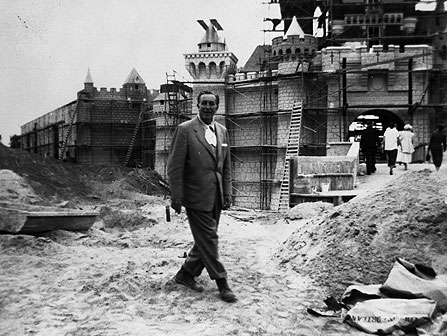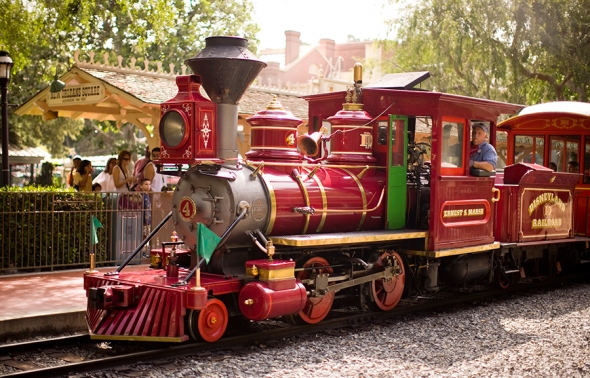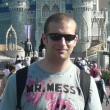The legacy
The plans for Disneyland that Roy used to secure the involvement of ABC were significantly grander than those that had been put forward for Mickey Mouse Park the previous year. After entering onto Town Square, guests would wander up a Main Street lined with nostalgia-inducing stores towards the towering Sleeping Beauty Castle. From the plaza in front of the castle, they would be able to reach several themed lands: True-Life Adventureland (inspired by Disney’s True-Life Adventure documentary films), the World of Tomorrow, Lilliputian Land, Fantasy Land, Recreation Park, Frontier Country, Treasure Island and Holiday Land.

Over time, these would evolve into the Disneyland that actually began construction in July 1954. True-Life Adventureland would become simply Adventureland, and the cruise down the “River of Romance” that was to be its headline attraction morphed into the Jungle Cruise. Fantasyland, with its attractions dedicated to Snow White, Peter Pan and Alice in Wonderland, survived largely intact. The Western-themed Frontier Country, featuring a pack mule ride and a second main street, evolved into Frontierland. Treasure Island, which was to sit in the center of a mock river and host the Mickey Mouse Club television show, became Tom Sawyer Island (inspired by Mark Twain’s The Adventures of Tom Sawyer). The World of Tomorrow, hosting a rocket ride to the moon and a miniature version of a freeway, was renamed as Tomorrowland.
Three of the original lands were dropped altogether. Recreation Park, a relaxing area that could be reserved by schools or clubs, was among them. So too was Lilluputian Land, although elements of it were absorbed into Fantasyland (most notably a canal boat ride past miniature figures, which would eventually become the Storybook Land Canal Boats). Holidayland would eventually open as part an expansion in 1957, but as a site for hosting large events rather than the constantly-changing, seasonal land that it was originally intended to be.
Mickey Mouse Park had been conceived as a combination of elements of Knott’s Berry Farm, heritage parks and traditional carnivals. Disneyland was undoubtedly significantly more ambitious – with its selection of themed lands and coherent transitions between them, it was to be the first true “theme park”. Nevertheless, elements of Mickey Mouse Park lived on in the Disneyland that opened in 1955, and many remain in the park even today.
The most prominent of these are the Town Square and Main Street, USA, which – like the main village of Mickey Mouse Park – are idealized recreations of a turn-of-the-century Midwestern town. Just like the village, Main Street, USA is “relaxing, cool and inviting”, as is the plaza that it leads to.
Many of the shops and other buildings that were to feature in the Burbank park found their way into Disneyland. There was a City Hall, which doubled as a guest services facility. A police station doubled as a “lost and found” location for a short period, and a fire station hosted a horse-drawn hose and chemical wagon and an alarm system. An Opera House was included, although it was initially little more than façade. Shops including a hobby shop, a music store, a magic shop and a candy shop all eventually found their way into the park.
Of the rides that were planned for Mickey Mouse Park, several matured into Disneyland attractions. A steam train circles Disneyland, just as it would have circled the smaller park. Horse-drawn streetcars pull guests up and down Main Street, USA. The Storybook Land Canal Boats are an evolution of the canal boat ride sketched out by Harper Goff, and riverboats circle Tom Sawyer Island just as they would have circled the small island in Goff’s drawings. The submarine ride concept put forward to Burbank officials eventually opened as the Submarine Voyage in 1959. The Western Village idea was imported wholesale for Frontierland, with Disneyland’s pack mule ride being similar to the proposed donkey pack train.
Other elements of Mickey Mouse Park were lost in the transition. The large movie theatre never became a reality. Several stores, such as the doll store, existed only on paper. Most notably, the carnival area – one that never seemed to sit well with Walt’s views on midway attractions – was dropped altogether.
So, Mickey Mouse Park never came to be. But the next time you visit a theme park, think about the influence that this ambitious little project has had on an industry that now entertains hundreds of millions of guests every single year.


Comments
Great bit of history!
Did you also know that there was a ski resort that Walt had invested in and was considering becoming a Disney destination ski resort? It is in the High Sierras. Near the town of Truckee California. It is called Sugar Bowl. It has Mount Disney and two lifts one called the Disney Express! It is also where he got his inspiration for "The Art of Skiing" with our Friend Goofy.
Actually, there were two possible ski resorts: Mineral King, south of Sequoia National Park, and Independence Lake, near Truckee. Disney helped design the Winter Olympics venue in Squaw Valley, California in 1960 and the other two projects followed.